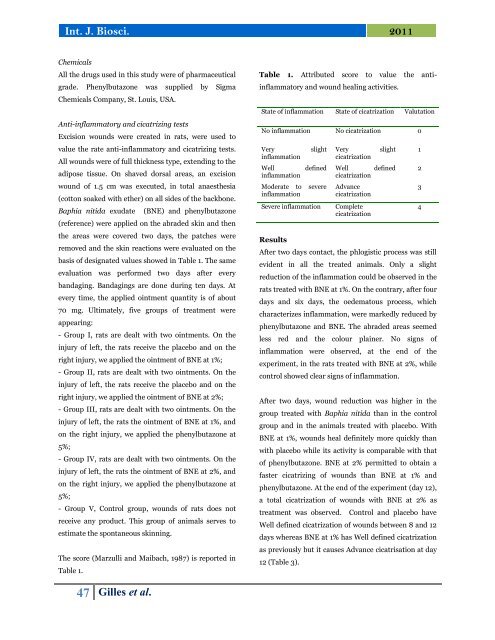Anti-inflammatory and cicatrizing activity of Baphia nitida Lodd. exudates
Abstract Baphia nitida exudate (BNE) is used in folk medicine for the treatment inflammation and cicatrisation of wounds in Côte d’Ivoire. BNE was formulated into an ointment and tested at two dose levels for anti-inflammatory and cicatrizing activity against excision wounds created on dorsal areas of rats. Both provide evidence for the ability of BNE to inhibit the inflammatory condition and to accelerate wound cicatrization on the rats. The activity was found to be dose related, and BNE at 2% was found to be best dose for the two tests used. Phenylbutazone cream used as a positive control reference was significantly active in both systems. These results provide a scientific basis for the traditional use of the exudate of Baphia nitida as an anti-inflammatory and cicatrizing agent.
Abstract
Baphia nitida exudate (BNE) is used in folk medicine for the treatment inflammation and cicatrisation of wounds in Côte d’Ivoire. BNE was formulated into an ointment and tested at two dose levels for anti-inflammatory and cicatrizing activity against excision wounds created on dorsal areas of rats. Both provide evidence for the ability of BNE to inhibit the inflammatory condition and to accelerate wound cicatrization on the rats. The activity was found to be dose related, and BNE at 2% was found to be best dose for the two tests used. Phenylbutazone cream used as a positive control reference was significantly active in both systems. These results provide a scientific basis for the traditional use of the exudate of Baphia nitida as an anti-inflammatory and cicatrizing agent.
Create successful ePaper yourself
Turn your PDF publications into a flip-book with our unique Google optimized e-Paper software.
Int. J. Biosci. 2011<br />
Chemicals<br />
All the drugs used in this study were <strong>of</strong> pharmaceutical<br />
grade. Phenylbutazone was supplied by Sigma<br />
Chemicals Company, St. Louis, USA.<br />
<strong>Anti</strong>-<strong>inflammatory</strong> <strong>and</strong> <strong>cicatrizing</strong> tests<br />
Excision wounds were created in rats, were used to<br />
value the rate anti-<strong>inflammatory</strong> <strong>and</strong> <strong>cicatrizing</strong> tests.<br />
All wounds were <strong>of</strong> full thickness type, extending to the<br />
adipose tissue. On shaved dorsal areas, an excision<br />
wound <strong>of</strong> 1.5 cm was executed, in total anaesthesia<br />
(cotton soaked with ether) on all sides <strong>of</strong> the backbone.<br />
<strong>Baphia</strong> <strong>nitida</strong> exudate (BNE) <strong>and</strong> phenylbutazone<br />
(reference) were applied on the abraded skin <strong>and</strong> then<br />
the areas were covered two days, the patches were<br />
removed <strong>and</strong> the skin reactions were evaluated on the<br />
basis <strong>of</strong> designated values showed in Table 1. The same<br />
evaluation was performed two days after every<br />
b<strong>and</strong>aging. B<strong>and</strong>agings are done during ten days. At<br />
every time, the applied ointment quantity is <strong>of</strong> about<br />
70 mg. Ultimately, five groups <strong>of</strong> treatment were<br />
appearing:<br />
- Group I, rats are dealt with two ointments. On the<br />
injury <strong>of</strong> left, the rats receive the placebo <strong>and</strong> on the<br />
right injury, we applied the ointment <strong>of</strong> BNE at 1%;<br />
- Group II, rats are dealt with two ointments. On the<br />
injury <strong>of</strong> left, the rats receive the placebo <strong>and</strong> on the<br />
right injury, we applied the ointment <strong>of</strong> BNE at 2%;<br />
- Group III, rats are dealt with two ointments. On the<br />
injury <strong>of</strong> left, the rats the ointment <strong>of</strong> BNE at 1%, <strong>and</strong><br />
on the right injury, we applied the phenylbutazone at<br />
5%;<br />
- Group IV, rats are dealt with two ointments. On the<br />
injury <strong>of</strong> left, the rats the ointment <strong>of</strong> BNE at 2%, <strong>and</strong><br />
on the right injury, we applied the phenylbutazone at<br />
5%;<br />
- Group V, Control group, wounds <strong>of</strong> rats does not<br />
receive any product. This group <strong>of</strong> animals serves to<br />
estimate the spontaneous skinning.<br />
The score (Marzulli <strong>and</strong> Maibach, 1987) is reported in<br />
Table 1.<br />
Table 1. Attributed score to value the anti<strong>inflammatory</strong><br />
<strong>and</strong> wound healing activities.<br />
State <strong>of</strong> inflammation State <strong>of</strong> cicatrization Valutation<br />
No inflammation No cicatrization 0<br />
Very<br />
inflammation<br />
slight<br />
Well defined<br />
inflammation<br />
Moderate to severe<br />
inflammation<br />
Severe inflammation<br />
Results<br />
Very<br />
cicatrization<br />
slight<br />
Well defined<br />
cicatrization<br />
Advance<br />
cicatrization<br />
Complete<br />
cicatrization<br />
After two days contact, the phlogistic process was still<br />
evident in all the treated animals. Only a slight<br />
reduction <strong>of</strong> the inflammation could be observed in the<br />
rats treated with BNE at 1%. On the contrary, after four<br />
days <strong>and</strong> six days, the oedematous process, which<br />
characterizes inflammation, were markedly reduced by<br />
phenylbutazone <strong>and</strong> BNE. The abraded areas seemed<br />
less red <strong>and</strong> the colour plainer. No signs <strong>of</strong><br />
inflammation were observed, at the end <strong>of</strong> the<br />
experiment, in the rats treated with BNE at 2%, while<br />
control showed clear signs <strong>of</strong> inflammation.<br />
After two days, wound reduction was higher in the<br />
group treated with <strong>Baphia</strong> <strong>nitida</strong> than in the control<br />
group <strong>and</strong> in the animals treated with placebo. With<br />
BNE at 1%, wounds heal definitely more quickly than<br />
with placebo while its <strong>activity</strong> is comparable with that<br />
<strong>of</strong> phenylbutazone. BNE at 2% permitted to obtain a<br />
faster <strong>cicatrizing</strong> <strong>of</strong> wounds than BNE at 1% <strong>and</strong><br />
phenylbutazone. At the end <strong>of</strong> the experiment (day 12),<br />
a total cicatrization <strong>of</strong> wounds with BNE at 2% as<br />
treatment was observed.<br />
Control <strong>and</strong> placebo have<br />
Well defined cicatrization <strong>of</strong> wounds between 8 <strong>and</strong> 12<br />
days whereas BNE at 1% has Well defined cicatrization<br />
as previously but it causes Advance cicatrisation at day<br />
12 (Table 3).<br />
1<br />
2<br />
3<br />
4<br />
47 Gilles et al.





![Review on: impact of seed rates and method of sowing on yield and yield related traits of Teff [Eragrostis teff (Zucc.) Trotter] | IJAAR @yumpu](https://documents.yumpu.com/000/066/025/853/c0a2f1eefa2ed71422e741fbc2b37a5fd6200cb1/6b7767675149533469736965546e4c6a4e57325054773d3d/4f6e6531383245617a537a49397878747846574858513d3d.jpg?AWSAccessKeyId=AKIAICNEWSPSEKTJ5M3Q&Expires=1716620400&Signature=xu9xTPLIahtCEh4puslDmsnn1qo%3D)












